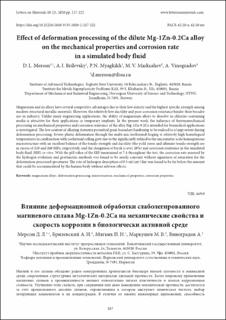| dc.contributor.author | Merson, Dmitry | |
| dc.contributor.author | Brilevsky, Alexander | |
| dc.contributor.author | Myagkikh, Pavel | |
| dc.contributor.author | Markushev, Mikhail | |
| dc.contributor.author | Vinogradov, Alexey | |
| dc.date.accessioned | 2021-09-07T06:38:11Z | |
| dc.date.available | 2021-09-07T06:38:11Z | |
| dc.date.created | 2021-01-17T21:19:16Z | |
| dc.date.issued | 2020 | |
| dc.identifier.citation | Letters on Materials. 2020, 10 (2), 217-222. | en_US |
| dc.identifier.issn | 2218-5046 | |
| dc.identifier.uri | https://hdl.handle.net/11250/2773878 | |
| dc.description.abstract | Magnesium and its alloys have several competitive advantages due to their low density and the highest specific strength among modern structural metallic materials. However, the relatively low ductility and poor corrosion resistance hinder their broader use in industry. Unlike many engineering applications, the ability of magnesium alloys to dissolve in chlorine-containing media is attractive for their applications as temporary implants. In the present work, the influence of thermomechanical processing on mechanical properties and corrosion resistance of the alloy Mg-1Zn-0.2Ca intended for biomedical applications is investigated. The low content of alloying elements permitted grain boundary hardening to be realised to a large extent during deformation processing. Severe plastic deformation through the multi-axis isothermal forging at relatively high homological temperatures in combination with isothermal rolling gave rise to the significantly refined to the micrometre scale homogeneous microstructure with an excellent balance of the tensile strength and ductility (the yield stress and ultimate tensile strength are in excess of 210 and 260 MPa, respectively, and the elongation at break is over 20 %) and corrosion resistance in the simulated body fluid (SBF) in vitro. With the pH value of the SBF maintained at 7.4 throughout the test, the corrosion rate assessed by the hydrogen evolution and gravimetric methods was found to be nearly constant without signatures of saturation for the deformation-processed specimens. The rate of hydrogen desorption of 0.5 ml / cm2 / day was found to be far below the amount that could be accommodated by the human body without adverse effects. | en_US |
| dc.language.iso | eng | en_US |
| dc.publisher | Institute for Metals Superplasticity Problems of Russian Academy of Sciences | en_US |
| dc.rights | Navngivelse 4.0 Internasjonal | * |
| dc.rights.uri | http://creativecommons.org/licenses/by/4.0/deed.no | * |
| dc.title | Effect of deformation processing of the dilute Mg-1Zn-0.2Ca alloy on the mechanical properties and corrosion rate in a simulated body fluid | en_US |
| dc.type | Peer reviewed | en_US |
| dc.type | Journal article | en_US |
| dc.description.version | publishedVersion | en_US |
| dc.source.pagenumber | 217-222 | en_US |
| dc.source.volume | 10 | en_US |
| dc.source.journal | Letters on Materials | en_US |
| dc.source.issue | 2 | en_US |
| dc.identifier.doi | 10.22226/2410-3535-2020-2-217-222 | |
| dc.identifier.cristin | 1872732 | |
| cristin.ispublished | true | |
| cristin.fulltext | original | |
| cristin.qualitycode | 1 | |

